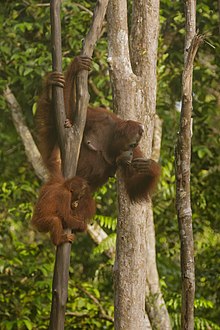Our website is made possible by displaying online advertisements to our visitors.
Please consider supporting us by disabling your ad blocker.
Bornean orangutan
| Bornean orangutan | |
|---|---|

| |
| Male | |

| |
| Female with infant both at Tanjung Puting National Park, Borneo | |
| Scientific classification | |
| Domain: | Eukaryota |
| Kingdom: | Animalia |
| Phylum: | Chordata |
| Class: | Mammalia |
| Order: | Primates |
| Suborder: | Haplorhini |
| Infraorder: | Simiiformes |
| Family: | Hominidae |
| Genus: | Pongo |
| Species: | P. pygmaeus
|
| Binomial name | |
| Pongo pygmaeus (Linnaeus, 1760)
| |
| Subspecies | |
| |

| |
| Distribution of Pongo pygmaeus in Borneo | |
| Synonyms | |
|
P. agris (Schreber, 1799) | |
The Bornean orangutan (Pongo pygmaeus) is an orangutan species endemic to the island of Borneo. It belongs to the only genus of great apes native to Asia and is the largest of the three Pongo species. It has a coarse, reddish coat and up to 1.5 m (4 ft 11 in) long arms. It is sexually dimorphic, with females ranging in body length from 1 to 1.2 m (3 ft 3 in to 3 ft 11 in) and males from 1.2 to 1.7 m (3 ft 11 in to 5 ft 7 in).
The Bornean orangutan inhabits Borneo lowland rain forests and Borneo montane rain forests up to an elevation of 1,500 m (4,900 ft). Its diet includes fruits, seeds, flowers, bird eggs, sap and vines. It is highly intelligent, displaying tool use and distinct cultural patterns. It is critically endangered, with deforestation, palm oil plantations, and hunting posing a serious threat to its survival.
- ^ a b Ancrenaz, M.; Gumal, M.; Marshall, A.J.; Meijaard, E.; Wich , S.A.; Husson, S. (2024) [amended version of 2023 assessment]. "Pongo pygmaeus". IUCN Red List of Threatened Species. 2024: e.T17975A259043172. doi:10.2305/IUCN.UK.2024-1.RLTS.T17975A259043172.en.
Previous Page Next Page



